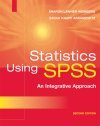Textbook Handbook / Manual
By: Sharon Lawner Weinberg(Author), Sarah Knapp Abramowitz(Author)
606 pages, 196 b/w illustrations, 100 tables
![Statistics Using IBM SPSS Statistics Using IBM SPSS]()
Click to have a closer look
About this book
Contents
Customer reviews
Biography
Related titles
Recommended titles
About this book
Written in a clear and lively tone, Statistics Using IBM SPSS: An Integrative Approach provides a data-centric approach to statistics with integrated SPSS (version 22) commands, ensuring that students gain both a deep conceptual understanding of statistics and practical facility with the leading statistical software package. With 100 worked examples, Statistics Using IBM SPSS: An Integrative Approach guides students through statistical practice using real data and avoids complicated mathematics. Numerous end-of-chapter exercises allow students to apply and test their understanding of chapter topics, with detailed answers available online. The third edition has been updated throughout and includes a new chapter on research design, new topics (including weighted mean, resampling with the bootstrap, the role of the syntax file in workflow management, and regression to the mean) and new examples and exercises. Student learning is supported by a rich suite of online resources, including answers to end-of-chapter exercises, real data sets, PowerPoint slides, and a test bank.
Contents
1. Introduction
2. Examining univariate distributions
3. Measures of location, spread, and skewness
4. Re-expressing variables
5. Exploring relationships between two variables
6. Simple linear regression
7. Probability fundamentals
8. Theoretical probability models
9. The role of sampling in inferential statistics
10. Inferences involving the mean of a single population when sigma is known
11. Inferences involving the mean when sigma is not known: one- and two-sample designs
12. Research design: introduction and overview
13. One-way analysis of variance
14. Two-way analysis of variance
15. Correlation and simple regression as inferential techniques
16. An introduction to multiple regression
17. Nonparametric methods
Customer Reviews
Biography
Sharon Lawner Weinberg is Professor of Applied Statistics and Psychology and former Vice Provost for Faculty Affairs at New York University. She has authored numerous articles, books, and reports on statistical methods, statistical education, and evaluation, as well as in applied disciplines, such as psychology, education, and health. She is the recipient of several major grants, including a recent grant from the Sloan Foundation to support her current work with NYU colleagues to evaluate the New York City Gifted and Talented programs.
Sarah Knapp Abramowitz is Professor of Mathematics and Computer Science at Drew University. She received her PhD in Mathematics Education from New York University and is an Associate Editor of the Journal of Statistics Education.
Textbook Handbook / Manual
By: Sharon Lawner Weinberg(Author), Sarah Knapp Abramowitz(Author)
606 pages, 196 b/w illustrations, 100 tables
"This is the third edition of a very popular and useful text. The focus is on using SPSS in the research process. The chapters have illustrative exercises and meaningful real data problem sets that not only make it convenient for teaching but also provide realistic experiences for students that will stay with them for many years. The book does a very good job presenting the challenge of data analysis and the experience of being a serious researcher looking at important problems; it illustrates how a variety of quantitative methods can be applied to real data to tease out and evaluate the inferences suggested by that data. I strongly recommend this book to instructors of a one- or two-semester introductory statistics course."
– Robert W. Lissitz, University of Maryland
"This text by Weinberg and Abramowitz is an excellent choice for an undergraduate or elementary graduate course for non-majors. Stressing concepts over computation, it focuses on essential material for students in education and the social sciences. The book reads easily, like a set of well-constructed lectures that begin with simple fundamental concepts. Yet modern and relatively advanced topics, such as uses of the bootstrap, are also treated. Rather than focusing on hand calculations, the book integrates instruction on using SPSS directly into the text. This enables student exploration of actual research data sets, beginning in the first chapters."
– James E. Corter, Columbia University
"This book covers a broad range of topics in introductory statistics, employing a hands-on, problem-based approach. The latest edition expands an already long list of topics to include bootstrap techniques and experimental design considerations. By providing detailed, worked-through examples based on real data and substantive research questions, the authors guide the student through the data analysis process from beginning to end. However, this is no 'cookbook' – each section builds on the concepts and techniques established previously, and the reader is encouraged to explore the nuances involved in effective statistical analysis. What is particularly unique about the authors' exposition is that it can be read on many levels; this book will serve well as a course textbook or as a handy reference for the applied researcher."
– Marc A. Scott, New York University



































